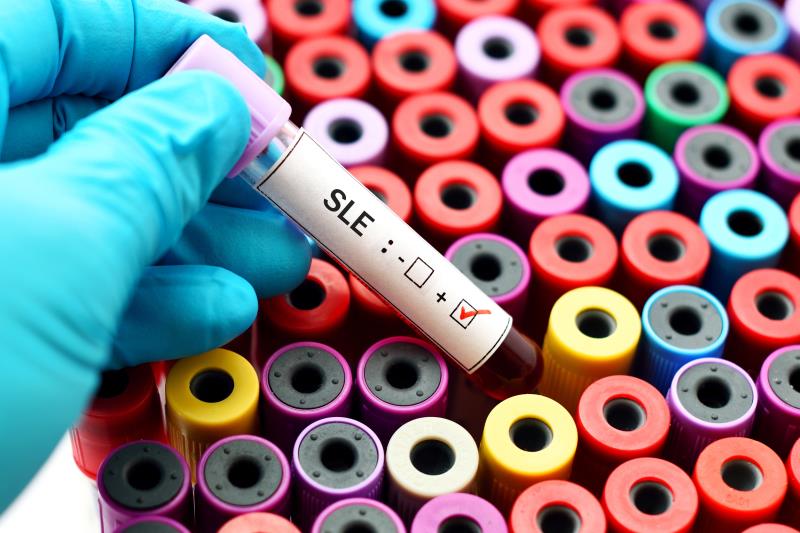
Low-dose interleukin (IL)-2 therapy may be effective for the treatment of active systemic lupus erythematosus (SLE), a study has shown.
“The management of active SLE is challenging due to the heterogeneous nature of the disease,” said the researchers. In SLE, sustained remission rates are low, and the currently available regimens are tied to significant adverse effects. [Ann Rheum Dis 2017;76:2071-2074; Best Pract Res Clin Rheumatol 2017;31:342-350; Lupus 2016;25:699-709]
Low-dose IL-2 has been shown to suppress inflammation and autoimmunity in type 1 diabetes, graft-vs-host disease (GVHD), hepatitis C-associated vasculitis, alopecia areata, and SLE. [Nat Med 2016;22:991-993; Ann Rheum Dis 2016;75:1407-1415; Retrovirology 2016;13:77]
To ascertain the benefits of low-dose IL-2 in SLE, 60 participants were randomized 1:1 to receive either subcutaneous IL-2 1 million IU or placebo on top of standard treatment*. One treatment cycle ran for 4 weeks, wherein injections were administered every other day for 2 weeks followed by a 2-week break. Participants received a total of three treatment cycles for the first 12 weeks and were followed up for another 12 weeks. [Ann Rheum Dis 2020;79:141-149]
At week 24, SRI-4** response rates were higher in the IL-2 vs the placebo arm (66 percent vs 37 percent; p=0.027). IL-2 therapy also yielded improvements in other domains such as 24-hour proteinuria (dropped from 1.55 g [baseline] to 0.48 g; p=0.002) and serum albumin (p=0.017).
There was a lower infection rate in the IL-2 vs the placebo arm (7 percent vs 20 percent). Only two serious infections were observed, both from the placebo arm. The most common adverse events were injection-site reactions (ie, pain, redness, and swelling), which were higher among IL-2 vs placebo recipients (31 percent vs 7 percent).
Other SLE manifestations
Of note was the improvement in alopecia among IL-2 recipients (n=7/12), which is consistent with evidence reflecting the efficacy of low-dose IL-2 for severe alopecia areata. [JAMA Dermatol 2014;150:748-751]
Furthermore, almost all cases of rash resolved completely (n=11/13), thus corresponding with a study showing improvement in GVHD-related erythema and scleroderma with low-dose IL-2 which, according to the researchers, boosts its potential in the treatment of autoimmune skin disorders. [Sci Transl Med 2013;5:179ra43-179r]
More than half of IL-2 recipients with lupus nephritis (LN) achieved complete remission vs placebo at week 24 (54 percent vs 17 percent; p=0.036). However, given the small fraction of patients with LN, and because the study was not designed to evaluate the effects of IL-2 on LN, studies focusing on low-dose IL-2 treatment in LN or other autoimmune kidney diseases should be carried out in the future, noted the researchers.
There were also more IL-2 recipients who reduced their background corticosteroid use (eg, prednisone) by ≥50 percent compared with placebo recipients at week 24 (45 percent vs 33 percent).
Other clinical manifestations present at baseline that completely resolved with IL-2 were oral ulcerations, vasculitis, and fever.
“[Our findings show that] SLE patients with active disease improved rapidly and significantly with low-dose IL-2 therapy … The improvement of disease activities was observed across a wide range of SLE manifestations,” said the researchers. “It was also clearly shown that the dose of corticosteroid could be reduced more during treatment with IL-2 than with placebo, which is clinically critical in SLE management.”
A novel treatment option for SLE?
Taken together, these findings suggest that low-dose IL-2 is a potential new therapy for a broad range of inflammatory and autoimmune disorders refractory to current regimens, underscored the researchers.
However, the lack of dose-ranging comparison and the use of background treatment should be taken into account, noted the researchers. “It is highly possible that individuals might respond differently to dosage regimen [and] background treatments such as calcineurin inhibitors [could have influenced our findings].”
Therefore, further studies with larger cohorts and longer treatment durations are warranted to determine the optimal dose of IL-2 therapy and establish its efficacy in inducing remission as per DORIS***, said the researchers. Stratification by background therapy may also shed light on the influence of background treatments in the efficacy of IL-2, they added.